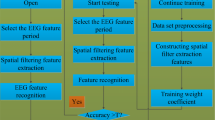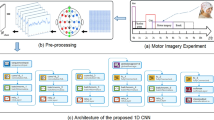Abstract
In emerging research field of interdisciplinary studies, EEG plays an important role in brain-computer interface due to the good portability, low cost and high temporal resolution of EEG devices. In this paper, a new neural network model called parallel deep neural network is proposed to extract the spatiotemporal features of the motor imagery EEG signal. Unlike traditional EEG classification algorithms, which often discard the EEG spatial feature, Fast Fourier Transform is performed on the EEG time series for each trial to construct 2-D EEG maps. The convolutional neural network is used in training the 2-D EEG maps to extract EEG spatial features. In addition, the original time series channel signals are trained in parallel based on long short-term memory to extract the EEG time series features. Finally, the spatial and temporal features are fused and classified using feature mosaicing. The experimental results show that the parallel deep neural network has good recognition accuracy and is superior to other latest recognition algorithms.
Access this chapter
Tax calculation will be finalised at checkout
Purchases are for personal use only
Similar content being viewed by others
References
Bajaj, V., Rai, K., Kumar, A., et al.: Rhythm based features for classification of focal and nonfocal EEG signals. IET Signal Process. 11(6), 743–748 (2017)
Arunkumar, N., Ramkumar, K., Venkatraman, V., et al.: Classification of focal and non focal EEG using entropies. Pattern Recogn. Lett. 94, 112–117 (2017)
Wu, D., King, J.T., Chuang, C.H., et al.: Spatial filtering for EEG-based regression problems in brain-computer interface (BCI). IEEE Trans. Fuzzy Syst. 26(2), 771–781 (2017)
Hassan, A.R., Bhuiyan, M.I.H.: A decision support system for automatic sleep staging from EEG signals using tunable Q-factor wavelet transform and spectral features. J. Neurosci. Meth. 271, 107–118 (2016)
Subasi, A.: Application of adaptive neuro-fuzzy inference system for epileptic seizure detection using wavelet feature extraction. Comput. Biol. Med. 37(2), 227–244 (2019)
Shiu, K., Alok, S.: A new parameter tuning approach for enhanced motor imagery EEG signal classification. Med. Biol. Eng. Comput. 56(10), 1861–1874 (2018)
Behrooz, N., Reza, B., Mansoor, Z.J.: An efficient hybrid linear and kernel CSP approach for EEG feature extraction. Neurocomputing 73(1–3), 432–437 (2009)
Sharma, M., Deb, D., Acharya, U.R.: A novel three-band orthogonal wavelet filter bank method for an automated identification of alcoholic EEG signals. Appl. Intell. 48(5), 1368–1378 (2018)
Purnamasari, P.D., Ratna, A.A.P., Kusumoputro, B.: EEG based emotion recognition system induced by video music using a wavelet feature vectors and an artificial neural networks. Adv. Sci. Lett. 23(5), 4314–4319 (2017)
Sumit, S.: High performance EEG signal classification using classifiability and the Twin SVM. Appl. Soft Comput. 30(3), 305–318 (2015)
Langkvist, M., Karlsson, L., Loutfi, A.: A review of unsupervised feature learning and deep learning for time series modeling. Pattern Recogn. Lett. 42, 11–24 (2014)
Tang, X., Zhang, N., Zhou, J., et al.: Hidden-layer visible deep stacking network optimized by PSO for motor imagery EEG recognition. Neurocomputing 234, 1–10 (2016)
Spampinato, C., Palazzo, S., Kavasidis, I., Giordano, D.: Deep learning human mind for automated visual classification. In: 2017 IEEE Conference on Computer Vision and Pattern Recognition, pp. 4503–4511. The Institute of Electrical and Electronics Engineers, Hawaii (2017)
Bashivan, P., Bidelman, G.M., Yeasin, M.: Spectrotemporal dynamics of the EEG during working memory encoding and maintenance predicts individual behavioral capacity. Eur. J. Neurosci. 40(12), 3774–3784 (2014)
Li, J., Struzik, Z., Zhang, L., et al.: Feature learning from incomplete EEG with denoising autoencoder. Neurocomputing 165, 23–31 (2015)
Author information
Authors and Affiliations
Corresponding author
Editor information
Editors and Affiliations
Rights and permissions
Copyright information
© 2020 Springer Nature Switzerland AG
About this paper
Cite this paper
Kong, D., Wei, W. (2020). Parallel Deep Neural Network for Motor Imagery EEG Recognition with Spatiotemporal Features. In: Silhavy, R. (eds) Artificial Intelligence and Bioinspired Computational Methods. CSOC 2020. Advances in Intelligent Systems and Computing, vol 1225. Springer, Cham. https://doi.org/10.1007/978-3-030-51971-1_7
Download citation
DOI: https://doi.org/10.1007/978-3-030-51971-1_7
Published:
Publisher Name: Springer, Cham
Print ISBN: 978-3-030-51970-4
Online ISBN: 978-3-030-51971-1
eBook Packages: Intelligent Technologies and RoboticsIntelligent Technologies and Robotics (R0)




